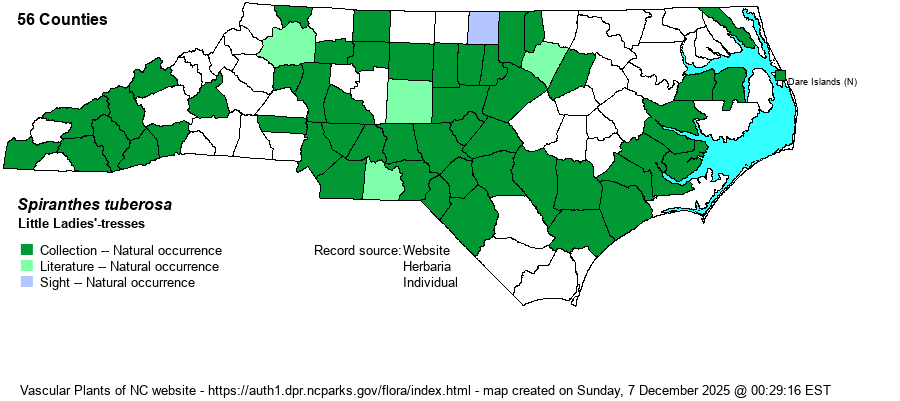| Author | Rafinesque | |
| Distribution | Roughly statewide in distribution, but large holes in the range are present. There are relatively few records for the northwestern Coastal Plain -- for no obvious reason, as well as very few for the northern Mountains.
This species has a wide range over the Eastern states, though it is infrequent in the northern portions. It ranges from MA west to MI and eastern KS, and south to southern FL and eastern TX. | |
| Abundance | Infrequent and easily overlooked in the Piedmont, the southern half of the Mountains, and the southern part of the Coastal Plain. Seemingly rare to uncommon in the northern Coastal Plain and the northern Mountains. Populations often are very small and thus easy to miss. | |
| Habitat | This ladies'-tresses has a wide array of habitats in the state, but it typically is found in mesic soils of sunny to partly sunny sites. It can be found in flatwoods, grassy fields, woodland borders, sandhills, and open woods. It is clearly not a wetland species like many other Spiranthes species found in the Coastal Plain. | |
| Phenology | This species blooms in midsummer into very early fall, from June into September. It fruits shortly after flowering. | |
| Identification | This is probably the smallest species of Spiranthes in the state, along with S. eatonii and S. ovalis. Its very slender stem is often just 6-10 inches tall, rarely to 1 foot tall. Along with the small stem, it has tiny white flowers as well, each being barely 1/5-inch (5 mm) long. The flowers are in a single rank, generally in a moderate to loose spiral. The top of the lip is completely white in this species; some other species have green or yellow on the top side of the lip. There are a few widely oval basal leaves, usually gone by the time of flowering. This is one of the few ladies'-tresses that is widely seen in the Piedmont and mountains, especially so in grassy and other sunny habitats. It is so small that an observer can easily walk by it, even when in full bloom. The main species to confuse with it, as both can bloom in late summer in drier grassy places well inland, is S. lacera. However, that latter species is taller, has larger flowers, and almost always has a green top of the lip. S. vernalis also grows in dry to mesic grassy places, but it blooms in the spring and is a much more robust species overall. | |
| Taxonomic Comments | The species was long known as Spiranthes grayi. It also had been known as S. tuberosa var. grayi, but it is now considered a valid species without varieties now.
| |
| Other Common Name(s) | Slender Ladies'-tresses, Little Pearl Twist (a poor colloquial name) | |
| State Rank | S3 [S4] | |
| Global Rank | G5 | |
| State Status | | |
| US Status | | |
| USACE-agcp | FACU link |
| USACE-emp | FACU link |

